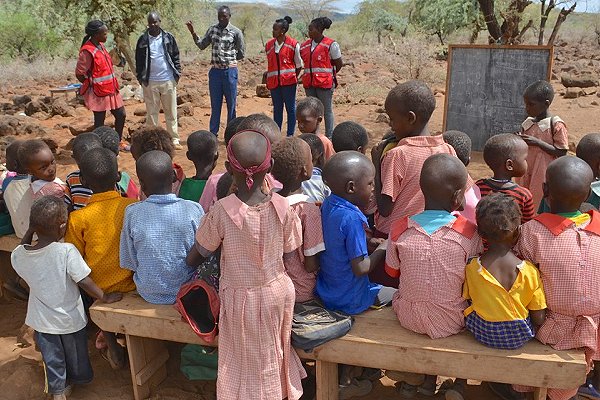
Kenya Red Cross: Heavy rains pound Nairobi but drought continues to torment other regions

(This story appeared first on the Kenya Red Cross and IFRC websites earlier this week. In the most recent local news report on seasonal flooding, the Red Cross Wednesday said some 700 people had been displaced in Taita Taveta county; a climate attribution study of the Kenyan drought was conducted last year.)
A group of children gather on two unsteady benches under a tree (photo). One of the benches is broken. A black board leans over another tree. This is the classroom of Nashipa pre-school in Singiraine village, Kajiado West.
The pupils of the school range from three to ten years. On their tiny faces you can clearly see the effects of drought, malnutrition and potential health issues.
The only black board the school possesses is divided into three: one corner is for the pre-unit, another for class one and the remaining corner for classes two and three.
The time they spend in school is also divided into morning and afternoon sessions to guarantee a place for everyone to sit.
‘I cannot say no to the parents’
“These children come from poor families and the drought has made it even worse. The school cannot afford to feed them. Most come to school very hungry and it affects their learning,” says Gideon Ntikika, the only teacher of the school.
Families are supposed to cover a school fee of 300 Kenya shillings (almost three US dollars) to cover the cost of teaching materials and the teacher’s salary. But most parents are in default due to the struggles caused by the drought. Ntikika is forced to manage the school at almost zero cost.
“I cannot say no to the parents when they plead with me to educate their children. I see their suffering,” he explains.
“Most are jobless, have lost all their livestock and are very poor.”
The school is in shortage of equipment of every kind. The textbooks are outdated and worn out and when it’s windy, the pages fly in all directions.
The bigger pupils share their pencils as they are costly to most parents. The children in baby class just play with each other, since they do not have crayons or drawing books.
“I personally even struggle to buy chalk, so we try to minimize the usage of the little I manage to get,” says Ntikika.
Scorching sun
He has been running the school since 2012. Every morning he walks for four hours to reach the school, and the same distance in the evening to return home.
The walk to the school is a real challenge for the pupils as well. At times some of them fail to attend due to the scorching sun that heats up the ground.
Most of the children do not have shoes and the soil literally burns their feet. Instead of a common uniform, they come wearing all kinds of uniforms and home clothes, some tattered.
“My biggest wish is to have real rooms with iron sheets, individual blackboards for each class and water storage tanks to tap water when it rains,” says teacher Ntikika.
“Salary support and availability of the teacher’s books would also be very helpful.”
Kajiado County is one of the most drought-affected counties in Kenya, enduring malnutrition and food insecurity. The Kenya Red Cross Society has been responding to the drought crisis in several counties since 2016, and intends to reach nearly 1.4 million people by July, providing food, cash and rehabilitation of water sources. (Photo: KRCS)